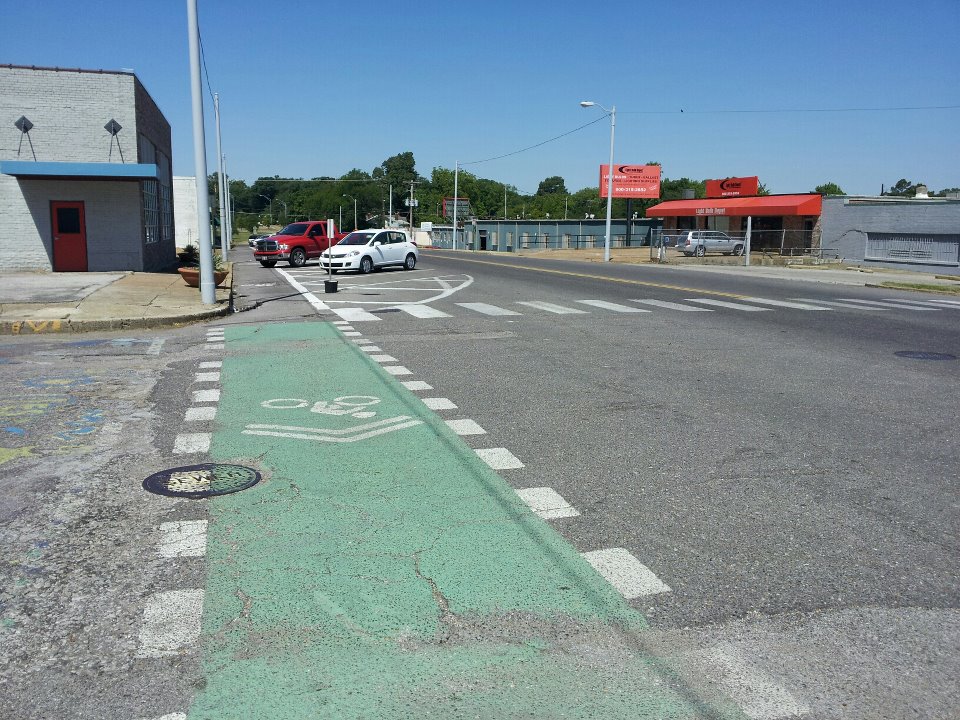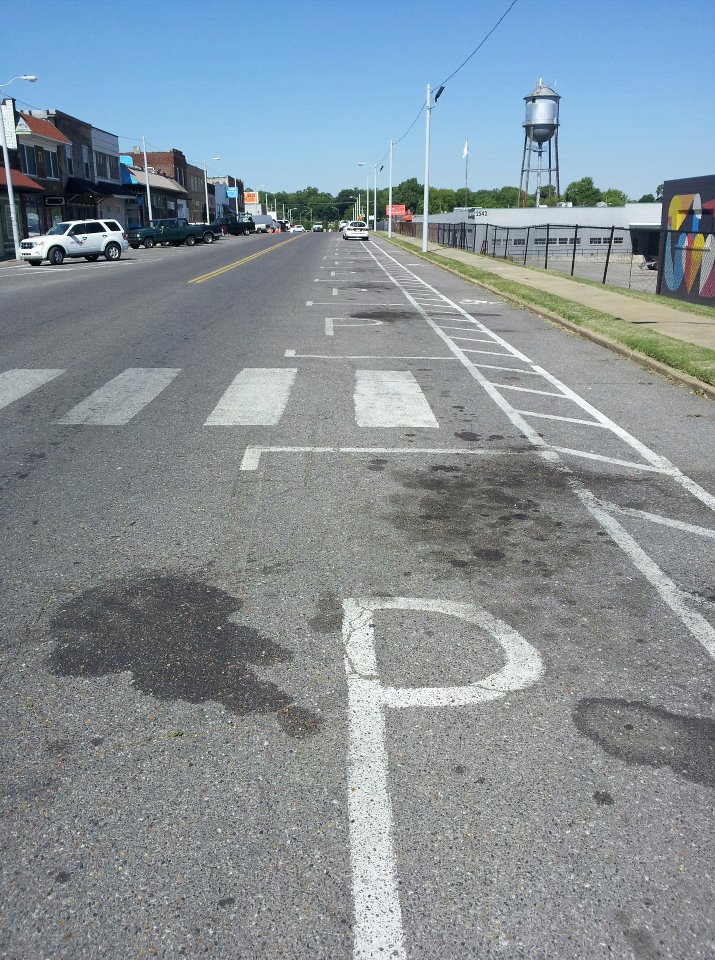Guerrilla Painting
Today is my last day here in Memphis, a city I am finding more endearing by the hour. As an outsider, I have a license to be both optimistic and critical. There are reasons for both, although I have found more justification for optimism here than many of the other places I have visited recently in this country. This city has a strong core, great bones, a rich history and -- to a person that I have met -- a tremendous inner spirit.
While the problems are deep, serious and systematic, I would bet on the resilience of Memphis more than the flashier cities I recently visited in California or the more affluent cities in Florida and Texas where we did Curbside Chats this spring. Part of that is a product of the fact that things have been tough here -- the crazy growth seen in California, Florida and Texas has largely passed this place by -- and so they don't suffer from the growth hangover (and huge overhang of obligations) that others face. They've actually had to start getting real already, something many other cities are still struggling to figure out. When I share the details of the growth Ponzi scheme, I find they already implicitly understand it. That's huge.
Unfortunately, the inertia of the American pattern of development is tremendous. Memphis, and the regional transportation programs they participate in, continue to invest in the low-productivity investments of horizontal expansion. At a time when their inner neighborhoods -- which have great structure and only need a little TLC to really make tremendous gains -- are badly in need of investment, the region has plans in place to spend billions on promoting new growth out on the periphery. One statistic I saw would add 1,100+ miles of new roadway, and this to a city that is projected limited to no growth in population.
Ironically, this is partly where my optimism comes from. Look at the huge amount of resources Memphis is looking to throw away on investments that have literally a negative return. We divert just a tiny fraction of that to investments that are productive -- investments in the neighborhoods, the people and the local business of Memphis -- and amazing things can happen. If Memphis actually commits to a Strong Towns vision, forsakes the Growth Ponzi Scheme and starts to make strategic investments based on a return-on-investment paradigm, this place could rocket upwards in prosperity.
So what does a high-return investment look like? For starters, it is not a stadium, a bridge, a highway, a new business from a foreign country that we pay to move here, a condo development with a huge parking ramp out along the third beltway, or any of the other "home run swings" Memphis has joined other cities across the country in taking. Understanding the simple math we demonstrated earlier this year in our post The cost of auto orientation (January 2, 2012) reveals the fact that the high-return investments are sitting right under our noses.
Here's a photo of a run down, overlooked, disconnected block here in Memphis. By the reports I received, a few years ago this place was totally dead. Today you have local entrepreneurs, artists and retailers opening up shop and looking to grow. So what turned this dead block around? Was it huge business subsidies? Was it a large investment by the city? Was it some type of tax breaks?
 Nope. As far as I can tell it was a local vision (partially facilitated by the city), some paint and some people that wanted to make things better. You'll notice in the photos here that the striping is not exactly high quality. This isn't a Memphis variant on rigid engineering standards. It is Guerrilla Painting, a Tactical Urbanism approach to incremental change.
Nope. As far as I can tell it was a local vision (partially facilitated by the city), some paint and some people that wanted to make things better. You'll notice in the photos here that the striping is not exactly high quality. This isn't a Memphis variant on rigid engineering standards. It is Guerrilla Painting, a Tactical Urbanism approach to incremental change.
 The people of this neighborhood went out with buckets of paint that they picked up at the local hardware store and painted these crosswalks, bike lanes and parking lanes. In the process they turned this desolate street into a place that has an emerging character. Is it the end-all-be-all. No, of course not. Has it made a difference? Absolutely.
The people of this neighborhood went out with buckets of paint that they picked up at the local hardware store and painted these crosswalks, bike lanes and parking lanes. In the process they turned this desolate street into a place that has an emerging character. Is it the end-all-be-all. No, of course not. Has it made a difference? Absolutely.
One of the reports I received indicated that rents for unoccupied space have increased by 50%. A 50% increase in commercial rents is going to translate into higher property values. Higher property values means greater tax receipts. If the city's development codes don't get in the way, this can translate into more investment in the neighborhood. If the city's engineering department stays supportive, these incremental gains can be solidified with permanent striping and a new, more neighborhood-scaled, street when a routine maintenance project happens in the future.
Don't look now, but you're seeing the impossible happen right here; a neighborhood bringing itself back. And it's happening with no public money, just modest support from the planning staff in helping facilitate the neighborhood vision and then a lack of resistance from the city engineer's and attorney's offices in allowing the intervention to take place.

Imagine what could happen if this isolated block were connected to the adjacent school and the surrounding neighborhood next time the major arterial that runs near it is repaired. Imagine if we diverted a tiny, tiny fraction of those billions were are planning to spend on the periphery chasing the elusive dream to making this happen today. Allowing people to flow back and forth, unhindered by the auto moat that has been erected around this site, would cost next to nothing in the course of a routine maintenance project but would again, incrementally and over time, pay enormous dividends, for this street and for the entire surrounding neighborhood.
There is one more important fact to point out, and it is critical to understanding how we build strong towns. Each one of these shops is operated by a local business owner. Not a worker, but someone local who owns the operation. That person lives here in Memphis. Their success is accountable to the community and not a set of distant owners or shareholders. Their prosperity is dependent on the success of their neighbors and the health of their city. In other words, they are invested deeply here and are not about to pick up and move to the next city that can give them a subsidy. They don't try to attract "consumers"; they serve their patrons. In a city that has seemingly lost what was once called a "merchant class" and replaced it with workers, management and government, this block represents an emerging vision for Memphis that is deeply respectful of Memphians.
Memphis, I want you to be a Strong Town. Let's make it happen.
Tonight I'll be speaking at 5:30 PM at Duck's Unlimited, 1 Waterfowl Place, sharing this information and much, much more in a Curbside Chat that is open to the public. If you are in the Memphis area, please come out and hear what is going on, introduce yourself to me and your neighbors and do what you can to make Memphis a Strong Town.
